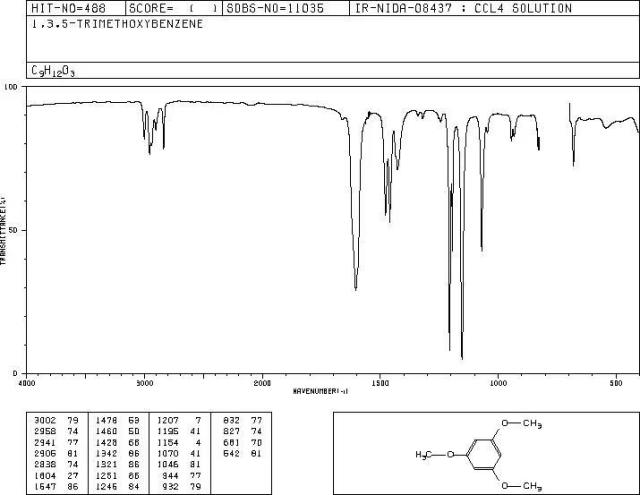
In practical applications, an appropriate detection method or a combination of multiple methods can be selected based on specific circumstances to enhance the accuracy and reliability of detection. Here are some common detection methods:
Determination of m.p. and b.p.: The sample's melting and boiling points are determined to be within the range of 50-53°C and 255°C at atmospheric pressure respectively.
Solubility test: 1,3,5-Trimethoxybenzene is insoluble in water but soluble in organic solvents such as ethanol and ether. Preliminary identification of the sample can be made by observing its dissolution in different solvents.
Functional group reaction: Reaction tests utilizing the chemical properties of the methoxy group (-OCH3). For example, methoxyl can participate in breaking or forming ether bonds; its presence can also be further verified through esterification reactions.
Color reaction: Certain chemical agents can react with 1,3,5-Trimethoxybenzene to produce a product with a specific color.

UV-Vis spectrum (UV-Vis): 1,3,5-Trimethoxybenzene exhibits a specific absorption peak in the ultraviolet region. Its absorption spectrum can be determined using UV-VIS spectrometry and compared with that of the standard product.
Infrared spectroscopy (IR): Infrared spectroscopy is an important tool for identifying organic compound structures. Characteristic absorption peaks for benzene rings and methoxy groups appear in the infrared spectrum of 1,3,5-Trimethoxybenzene; comparison between the sample's infrared spectrum and that of the standard product allows determination.
Nuclear magnetic resonance spectroscopy (NMR): This method provides detailed information about hydrogen and carbon nuclei in molecules—a crucial means for analyzing organic compound structures. By comparing NMR spectra between samples and standard products we confirm whether they contain 1,3,5-Trimethoxybenzene details.
Gas chromatography (GC) & Liquid chromatography(LC): Both these methods separate compounds within mixtures effectively. By selecting appropriate columns & detectors, 1,3, 5-Trimethoxybenzene in a sample can be isolated from other compounds and its presence can be confirmed by comparing retention times and characteristic peaks with the standard.